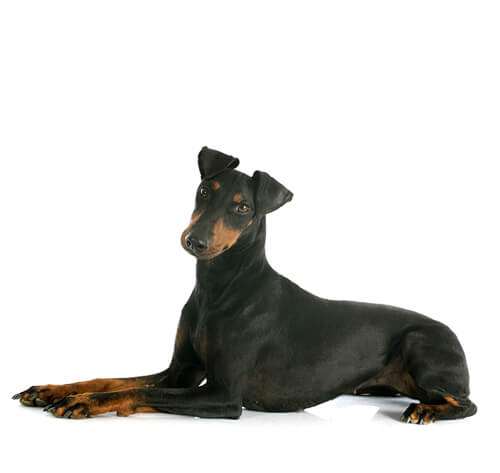
The lively Manchester Terrier is an agile, compact dog originally bred to hunt rats. Sturdy yet elegant, the breed has two size varieties: Toy and Standard. He is loyal, courageous and alert, making him an excellent companion and watchdog. This intelligent, charming dog can be quite energetic, so moderate exercise on a leash is important. The sleek coat of the Manchester Terrier requires minimal grooming.
DID YOU KNOW? The Toy and Standard Manchester Terriers have the same characteristics except for size and ear shape. The Standard’s ears can be upright or cropped, while the Toy’s ears are to remain erect. Developed by John Hulme in Manchester, England, in the 1800s, the Manchester Terrier is a cross between the Whippet
The need-to-know
- Dog suitable for owners with some experience
- Some training required
- Enjoys active walks
- Enjoys walking an hour a day
- Small dog
- Minimum drool
- Requires grooming once a week
- Non hypoallergenic breed
- Very vocal dog
- Guard dog. Barks and alerts
- May require training to live with other pets
- May require training to live with kids
Personality

Whilst elegant and refined, the Manchester Terrier was, and remains, a tenacious, larger than life character, all that a terrier should be.
The Manchester Terrier is bright, intelligent, alert, loyal and affectionate to their family and keen to be involved in whatever activity is going on, yet small enough to be economical to keep and naturally neat and clean. They are typical terriers in that they are active and on the go all the time, often enjoy digging and may not be safe with unknown cats or small furry animals.
History and Origins

Country of Origin: England
Black and tan terrier types were used for pest control and sport in Elizabethan times and this remained the case for centuries. In the mid 19th Century, longer legged dogs similar to Whippets were introduced, producing a taller and more refined terrier. Then known as ‘The Gentleman’s Terrier’ this smart, useful dog became known as the Manchester Terrier toward the end of the 19th century, thanks to the popularity of the breed in the city and particularly in the cotton mills of Manchester.
Nutrition and Feeding

Small dogs, such as the Manchester Terrier, have a fast metabolism, meaning they burn energy at a high rate. But their small stomachs mean that they must eat little and often. Small-breed foods are specifically designed with appropriate levels of key nutrients and smaller kibble sizes to suit smaller mouths. This also encourages chewing and improves digestion. Discover more about how to offer your dog a balanced diet with our easy-to-follow guide.
Exercise

This is an active terrier who needs at least an hour’s physical dog exercise daily, with training, games and mental stimulation as well. The Manchester Terrier has the stamina to go all day and a low tolerance for boredom so interactive toys will help keep their mind and bodies busy. They will enjoy activities that fulfil their need to hunt, find and ‘kill’ and this need can be met via a variety of dog sports and with suitable toys.
Other Information

Health and Common Issues
The Manchester Terrier is generally a healthy breed. In common with many small dog breeds, they can develop patella luxation (slipping kneecaps). An inherited bleeding disorder (von Willebrand's disease) is also recognised in this breed. Check with Breed Clubs and the Kennel Club for the latest health updates.
Space Requirements
The Manchester Terrier is a neat, compact little dog who is easily kept clean and tidy and requires a warm bed or lap, but not much more. Suitable for any sized home as long as a secure yard or garden is provided, and safe places for off lead exercise can be found.
Training Manchester Terrier
This is a sharp, clever breed who will enjoy puzzle solving and working with their person, but they have an independent nature, so learning how to motivate a Manchester Terrier and get the best out of them is key. Once motivated, they can be surprisingly trainable. Teaching a recall is vital as their desire to hunt can lead them astray. Good dog socialisation from an early age particularly with other dogs is key to ensuring these ‘Gentlemen’ do not get off on the wrong foot with others. You can find out more about dog training and a few good tricks for Manchester Terriers with our article.
Best Family Dog Breeds
The Manchester Terriers small size can be too appealing to very young children, and they are still a feisty, opinionated Terrier not inclined to tolerate being manhandled. With older children however, the Manchester Terrier can make a fun companion, up for all manner of games and activities, from a game of football in the park to a hike through the hills, this is a ‘do it all’ type of dog. While many dogs are traditionally thought of as being good with children, all dogs and children need to be taught to get on with each other and be safe together. Even so, dogs and young children should never be left alone together and adults should supervise all interactions between them.
Did You Know?
- The Manchester Terrier is often said to resemble the Dobermann in miniature, however the truth is, it is the other way round. The Dobermanns creator, Herr Louis Dobermann, used Manchester Terriers to create his breed.
- The Victorian nickname ‘The Gentlemans Terrier’ may have been a little bit tongue in cheek! Though the Manchester Terrier was a smarter and more elegant terrier than most at the time, they were still a fairly disreputable ratting, rabbiting, sporting breed - all activities favoured by the somewhat less than ‘gentlemanly’ fellows of the era.